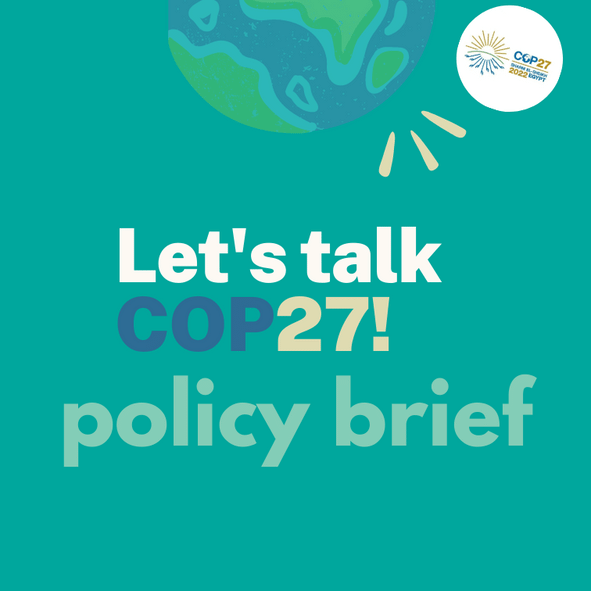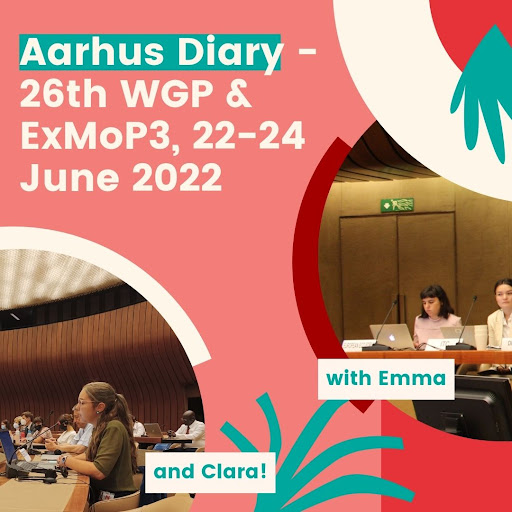Practical information
-
When
Tuesday 4th July at 16.45h CEST
-
Where
Online
-
How
Register your interest
Share This Event
What is climate litigation and why is it becoming more and more prevalent in youth climate activism? What do we mean with “climate activism through the rule of law”? What are the challenges faced by youth groups who decided to take States to court for climate inaction?
These and many more questions will be addressed during our workshop, which will provide the basics of climate litigation and an interactive conversation with a representative of the youth behind the Aurora climate lawsuit and of the Sweden’s Environmental Association of Law (SEAL)!
Agenda of the event:
- Introduction to Climate Litigation: What is it? How does it work?
- The Aurora Climate Case: A conversation with Ida Edling, the legal and scientific coordinator of Aurora
- Presentation of Sweden’s Environmental Association of Law
- Q&A
Have questions? Get in touch!
Other upcoming events
When youth sue the state | Workshop
https://yeenet.eu/wp-content/uploads/2023/06/A-CONVERSATION-WITH-THE-YOUTH-BEHIND-THE-AURORA-CLIMATE-LAWSUIT.png 675 675 YEE https://yeenet.eu/wp-content/uploads/2018/11/logo-yee-728x1030.png YEE2023-06-28 15:29:102023-07-11 17:44:15When youth sue the state | WorkshopGreen Colonialism | Webinar
The large-scale deployment of solar and wind capacities, along with electric batteries, is particularly demanding in critical raw materials, most of which are currently imported.
Could this trend amount to a new form of colonialism?
Practical information
-
When
3rd July 2023
-
Where
Online
-
Fees
Free
Share This Event
Have questions? Get in touch!
In the third webinar of the AmPower series we explore the notion of “Green Colonialism”! What is that all about?
With each new legislative package adopted in the framework of the European Green Deal, the target of renewable energy deployment has increased. The current pledge is at 42,5% of the European overall Energy mix by 2030. But the large-scale deployment of solar and wind capacities, along with electric batteries, is particularly demanding in critical raw materials, most of which are currently imported from 3rd countries.
Could this trend amount to a new form of colonialism? Is the European Commission tackling this issue head-on with its proposal for a raw critical material act?
Speakers
 Stephanie Richani is the advocacy lead at Equinox Initiative for Racial Justice. Equinox Initiative for Racial Justice is a people of colour-led initiative working to advance rights and justice for all people in Europe. We work in solidarity with a coalition of racial and social justice leaders and organisations to influence European Union law and policy.
Stephanie Richani is the advocacy lead at Equinox Initiative for Racial Justice. Equinox Initiative for Racial Justice is a people of colour-led initiative working to advance rights and justice for all people in Europe. We work in solidarity with a coalition of racial and social justice leaders and organisations to influence European Union law and policy.
 Emily Iona Stewart has a background in European labour law. Emily first began working on environment and climate issues a decade ago as the chief policy advisor to the Vice Chair of the European Parliament’s Environment Committee.
Emily Iona Stewart has a background in European labour law. Emily first began working on environment and climate issues a decade ago as the chief policy advisor to the Vice Chair of the European Parliament’s Environment Committee.
She has specialised in European climate and sustainability policy, playing a decisive role in forming the EU’s Sustainability strategy, which eventually led to the European Green Deal. Working across political lines, Emily has also authored legislation on supply chains, biofuels, and land rights.
Emily is the Climate Advocacy Specialist for the Open Society Foundations Just Transition pillar. In this role, she helps form OSF strategy on European climate policy, as well as maintaining and influencing networks within the European policy landscape.
Missed the webinar? Catch the recording now!
Other upcoming events
Green Colonialism | Webinar
https://yeenet.eu/wp-content/uploads/2023/06/Webinar-Energy-Policy-Instagram-Post-Square17.png 540 540 Eva Kloudová https://yeenet.eu/wp-content/uploads/2018/11/logo-yee-728x1030.png Eva Kloudová2023-06-26 14:15:572024-10-25 12:55:27Green Colonialism | WebinarINC-2: a session for nothing?
Why is it so difficult to reach an international treaty on plastic pollution?
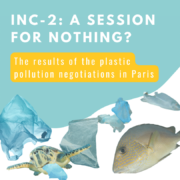
Written by

Mathilde Angeledei
Contents
Visual summary












Share this article
A new phase of the international treaty to end plastic pollution negotiations took place in Paris, at UNESCO headquarters, from May 29 to June 2, 2023.
Plastic has become one of the most significant sources of water and soil pollution.
According to the latest OECD figures, 460 million tonnes of plastic waste are produced every year. This figure has doubled since 2000 and is set to triple by 2060.
Although several countries have taken measures to deal with plastic waste, such as the European Union with its Directive on single-use plastic in 2019, or Rwanda in 2008, which was the first country in the world to ban plastic bags, 75% of the plastic waste found in the oceans comes from poor waste management. Indeed, most countries do not have the infrastructure to manage their own plastic waste.
Others, like Japan, export over 90% of their plastic waste to developing countries that have no means of recycling it. Plastic waste is at best burnt, at worst abandoned in the wild, creating huge open-air dumps. China produces 32% of the world’s plastic, a leap of 82% in ten years. What’s more, 10% of the world’s plastic is emitted by soda giants Coca and Pepsi.
Finally, the treaty is also part of the drive to move away from fossil fuels, as plastic is a direct derivative of petroleum.
Why is it so difficult to reach an international treaty on plastic pollution?
The Fifth United Nations Environment Assembly adopted a landmark resolution in Nairobi, Kenya, in March 2022 with a view to negotiating a legally binding global treaty to combat plastic pollution by the end of 2024. It will be based on a comprehensive approach covering the entire life cycle of plastics. To achieve this, five working sessions are planned, the first of which was held in Uruguay in November 2022. This first session laid the groundwork for future discussions by identifying the expectations and ambitions of the main delegations, with France hosting the second negotiating session.
An urgent treaty, yet negotiated at a snail’s pace
The second negotiation session got off to a rocky start, with more than two days lost on protocol issues. A coalition led by Saudi Arabia, Brazil, China, and India clashed with the presidency over whether or not to resort to voting in the event of a lack of unanimity in the future consideration of a draft treaty. The resolution of the controversy was postponed.
Finally, after a week, the Committee decided that “The International Negotiating Committee [INC] requests its Chairman to prepare, with the assistance of the Secretariat, a draft first version of the legally binding international treaty“. The text will be examined in November at the third meeting of this committee in Nairobi, then in April 2024 in Canada, and in November 2024 in South Korea, with the aim of a definitive treaty by the end of 2024.
Non-governmental observers
The treaty process includes the possibility for non-governmental observers to attend almost all the negotiations. However, at the Paris session, due to the size of the room, only one person per NGO could be present. Despite a statement signed by many associations, the length of the negotiations did not allow many NGOs to make any comments. It is therefore very important to follow the treaty news on the United Nations Environment Programme page, and the CIEL page which is in charge of coordinating the youth NGO accredited to the treaty.
An urgent treaty, yet negotiated at a snail’s pace – that’s how we might sum up this second phase of negotiations. We can only hope that future negotiations in Nairobi will be more prolific. In particular, the 175 countries will have to agree on the definition of plastic waste and the potential creation of a fund to help developing countries manage this waste.
And finally, there remains the thorny question of plastic waste already in the environment: who will be responsible for paying for its management?
More articles
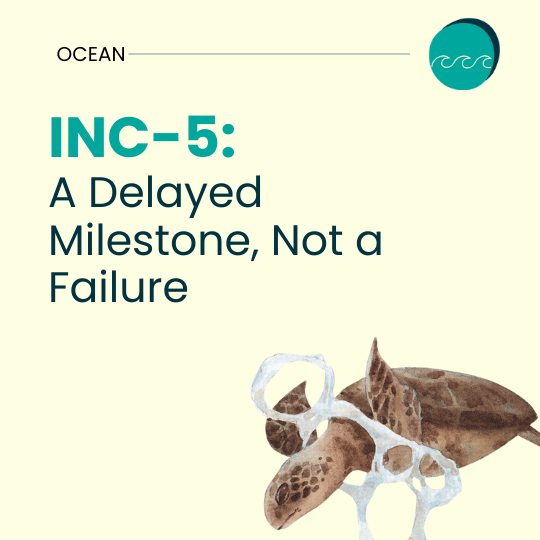
This session was supposed to be the “end of the beginning,” when the world would step out with the first-ever global plastic
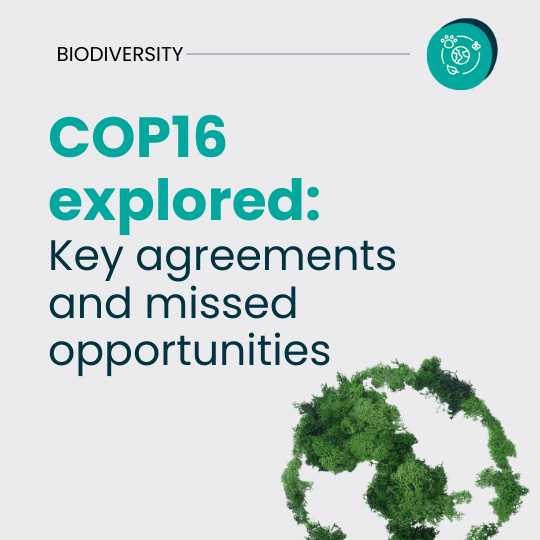
The conclusion of the 16th meeting of the Conference of Parties to the Convention on Biological Diversity (CBD COP16) marks a pivotal
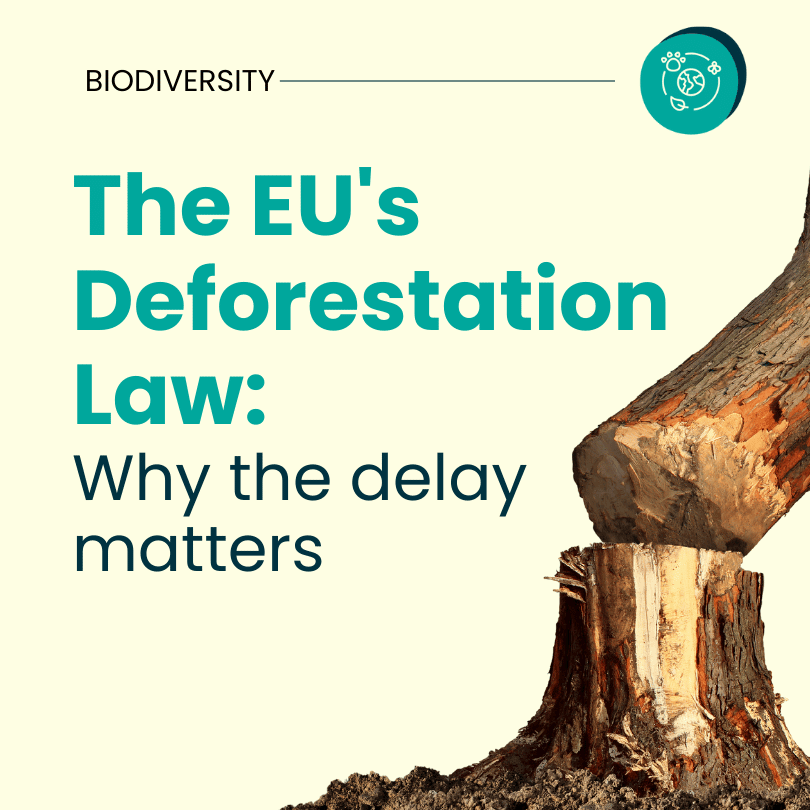
Despite the law’s importance in combating deforestation, the European Union recently announced a 12-month delay.
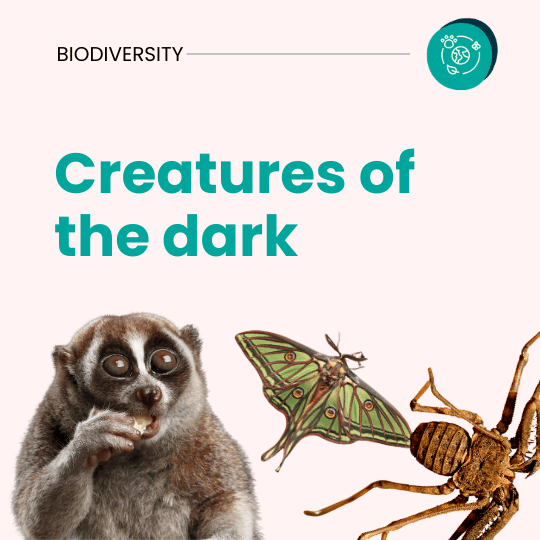
While nighttime activities are popular with humans for a few nights a year, some creatures keep it creepy all year round.
More To Explore
INC-2: a session for nothing?
https://yeenet.eu/wp-content/uploads/2023/06/The-results-of-the-plastic-pollution-negotiations-in-Paris.png 810 810 Eva Kloudová https://yeenet.eu/wp-content/uploads/2018/11/logo-yee-728x1030.png Eva Kloudová2023-06-23 09:15:542023-06-23 09:23:43INC-2: a session for nothing?Our future at stake: European youth urges once again to adopt an ambitious Nature Restoration Law
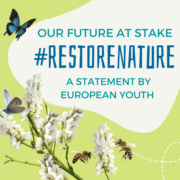
We, as concerned youth all over Europe, want to reiterate the necessity and urgency to adopt the Nature Restoration Law within the European Parliament.
What is being negotiated is not only a law: it is our future.
Young people and future generations deserve to grow up and live in healthy nature and functioning ecosystems. This, looking at the gloomy status of European species and habitats, can only be reached with an ambitious law that prescribes effective action now.
A watered-down law means postponing on us, later, the efforts that should be made now – and this is not fair.
The rejection attempts by conservative and right-wing groups, led by the European People’s Party (EPP), are alarming, are failing youth, and are failing to consider us as stakeholders of the present and the future.
While we appreciate the efforts of other parliamentary groups such as the Socialists and Democrats (S&D), the Greens, and the Left, who have stood their ground and voted in favor of the Nature Restoration Law, we are disheartened by the disinformation campaign around this law. Spreading falsehoods and withdrawing from negotiations only hinders the progress necessary to address climate change and nature loss, gambling our future.
As the vote on the remaining amendments and the final report approaches on June 27th, we call on all Members of the European Parliament to prioritize the future of our planet and live up to their promises to youth. The Nature Restoration Law is not merely an environmental issue, it is a matter of intergenerational equity.
Help us spread the word! Share this statement
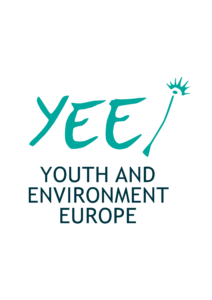
“Let’s state it clearly: the success of the EU Green Deal depends on the adoption of the Nature Restoration Law. This is not just a political vote, but a matter of justice: the youngest and future generations, who will face the biggest impacts from climate change, need to be supported by strong environmental legislation today to be able to exercise many of their human rights tomorrow. The only fact that the law risks being blocked is a shame, and shows once again that the EU is not taking the climate crisis seriously. For the sake of the EU credibility and climate leadership globally, we urge policy-makers and political parties to align and adopt the law, as we are still on time to avoid the mistake of the century.“

“On June 15th, the ENVI committee narrowly avoided a terrible setback for nature, by defeating attempts of right-winged groups to reject the Nature Restoration Law. While young Europeans can breathe a sigh of relief, the race to nature recovery is not over yet. As the voting continues on June 27th, European youth worry about what their future is going to look like.Young people have a right to live on a healthy and habitable planet, and political representatives have a duty to secure their future and the future of our next generations.“

“Despite positive steps at the last voting session, the sharp split in ENVI and the tight votes are worrying youth. In such short time spans, young Europeans have witnessed so much nature degradation, with very little improvement and increasing negative trends despite existing laws. This means that a strong law is not just an ambition, it is a necessity to get out of the business-as-usual framework: we need a game-changer. We urge MEPs to recognize this and vote (also) for the future of those that will have to deal with the consequences of current inaction, for our children and grandchildren. Together we can rally the resilience of nature to ensure functioning and healthy ecosystems, bringing not only food security but also hope to European citizens.”

“The Nature Restoration Law is not only a matter of urgent importance for European Nature and critical for the living conditions we as youth will face in the future – it is also a crucial signal we are sending to other countries to live up to the commitments made in Montreal in December last year. Who, if not us, can be the ones going ahead and restoring our degraded landscapes? How can we expect other countries to live up to their promises, if we can’t do it? The European Union now has a chance to secure a better planet for the youth here and elsewhere in the world.”

“The EU ratified the Global Biodiversity Framework in Montreal this Christmas, promising the world that restoring Nature would be the top priority. The Nature Restoration Law is the fruit of that labor. A great tool to finally reverse the loss of biodiversity. We cannot falter at the finishing line and reject the most crucial biodiversity legislation in Europe of this century. The Nordic youth urge our decision-makers in the EU to do what is right for the existing and future generations and vote YES to this Law.”

“Backed by scientific evidence, the Nature Restoration Law emerges as a transformative force that benefits both nature itself and humanity at large. Youth, as custodians of the future, urgently need this law to secure a thriving planet. It signifies a profound commitment to safeguarding biodiversity's intrinsic value, preserving the web of life that sustains us all. Recognizing that our own survival is intricately linked to the well-being of nature, we implore the Members of the European Parliament to secure a strong, ambitious Nature Restoration Law and forge a path towards a harmonious coexistence with the natural world.”

Only with intact ecosystems do we have a chance of overcoming the climate crisis. The proposed legislation would contribute significantly to the implementation of the EU's environmental and climate goals, safeguard the livelihoods of numerous species, and ultimately create a secure future for young and future generations. If the opposition and pushback against this law ought to show us one thing, it shows that the law has the potential to be truly transformative, this is why we see regressional voices spreading false information and doing dirty campaigning – they are afraid of transformative change! This short-sightedness and ignorance towards the ecological crises of our time endanger our future. No matter if on EU, national or regional level: those who block nature conservation and restoration today are jointly responsible for the advancement of the climate crisis and the stability of our future!"
Read the youth position on EU Nature Restoration Regulation.
The coalition of youth organizations whose representatives released the statements above that elaborated the youth position represents more than 20 million young Europeans.
Learn more about the #restorenature campaign
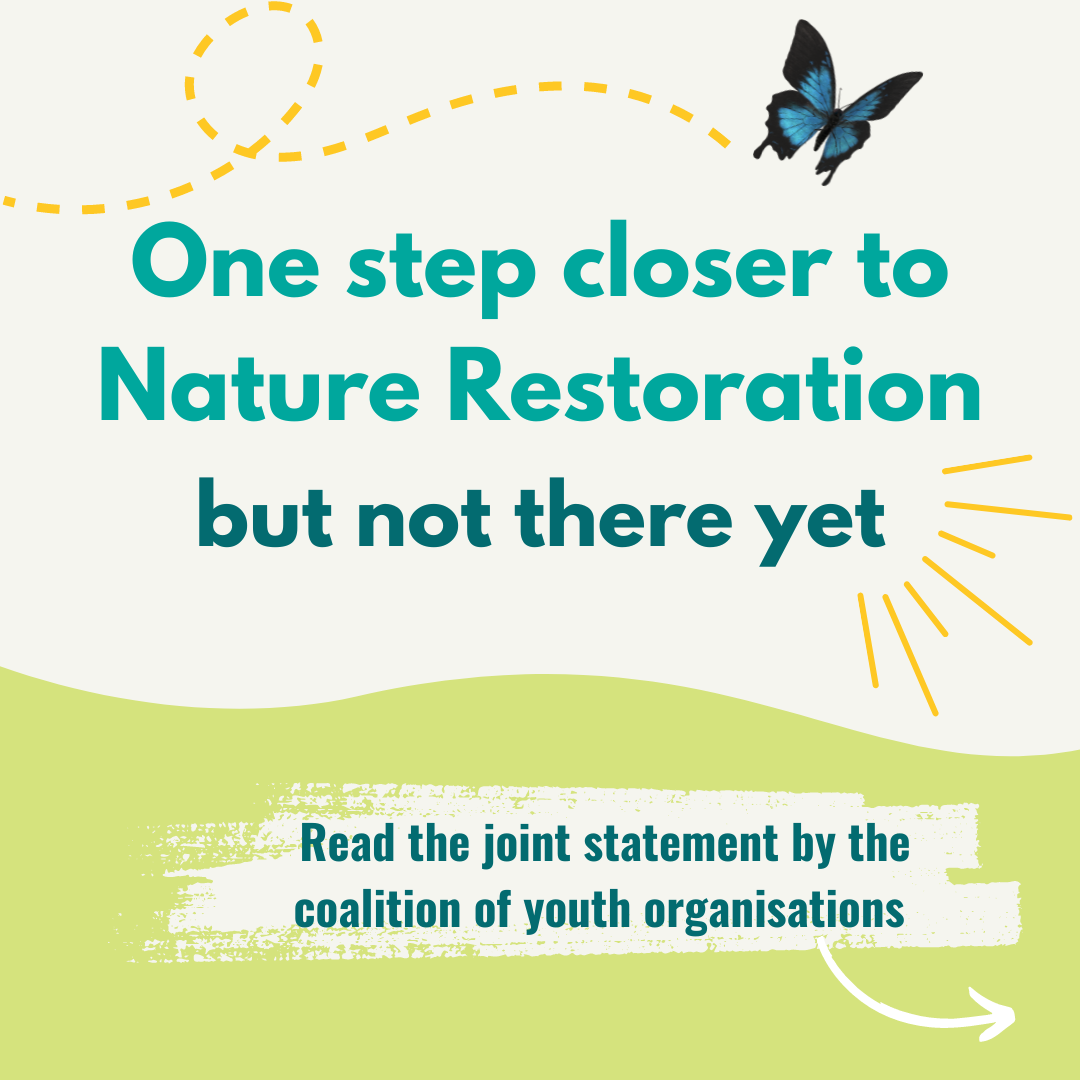
The recent positive vote for the Nature Restoration Law by the European Parliament sends a strong message on the obligation to restore
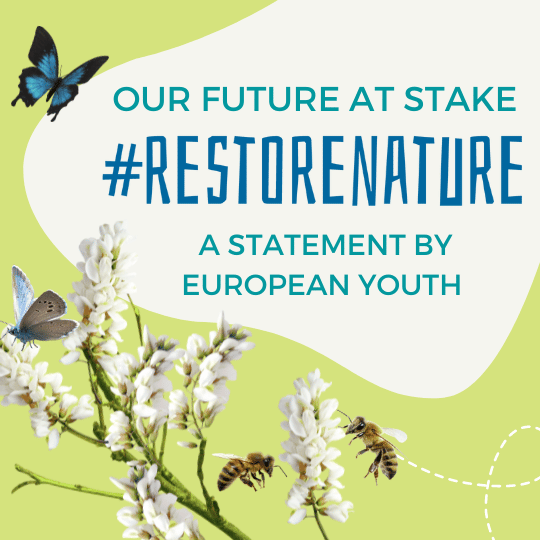
The coalition of youth organisations released their statements about the necessity and urgency to adopt the Nature Restoration Law within the European

Join us and over 200 NGOs and ask your decision-makers to adopt a solid and urgent implementation of the law that can
More To Explore
Our future at stake: European youth urges once again to adopt an ambitious Nature Restoration Law
https://yeenet.eu/wp-content/uploads/2023/06/OUR-FUTURE-IS-AT-STAKE.png 540 540 YEE https://yeenet.eu/wp-content/uploads/2018/11/logo-yee-728x1030.png YEE2023-06-21 10:50:072024-02-26 16:32:10Our future at stake: European youth urges once again to adopt an ambitious Nature Restoration Law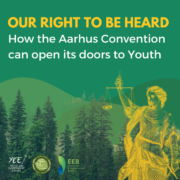
Written by
Margarida Martins (EEB), Ruby Silk (EEB) and Emma Pagliarusco (YEE)
Contents
Visual summary










Share this article
What is the Aarhus Convention and why is it important for young people and future generations?
Climate change poses real threats to the future of the youngest generations through both extreme and gradually escalating weather events, with manyfold repercussions. This looming threat has even proven to lead to “climate anxiety”, a serious and negative psychological phenomenon affecting the current generation of young people in particular and associated with the “perceived failure by governments to respond to the climate crisis”.
The latest IPCC report echoes these disproportionate threats to the youngest generations and sheds light on the intergenerational dimension of the climate change problem: in order to respect, protect and fulfil the rights of today’s youth and future generations, there is an urgent need for environmental laws which are more ambitious than ever before and implemented in the fastest possible way.
The Aarhus Convention and young people
Since its adoption in 1998, the Aarhus Convention has been hailed as the leading international agreement on environmental democracy. It has brought three key environmental rights to our doorsteps: the right to information, public participation in decision-making and access to justice in environmental matters.
The idea underpinning the Convention is no other than participatory democracy: to empower citizens and civil society to participate in environmental matters. For this reason, national authorities of State Parties are legally bound to make Aarhus rights effective. This means that they have to ensure the implementation as well as enforcement of the Aarhus provisions within public processes. Since its enactment, numerous Communications have been brought by NGOs as well as individuals to the Aarhus Convention Compliance Committee to challenge state practices, with energy and spatial planning being the most common sectors addressed.
Article 3(8) of the Convention also states that Parties shall ensure that persons who exercise their Aarhus rights are not penalised for their involvement. This is critically important since environmental defenders are constantly and increasingly under attack across the globe, facing intimidation, harassment, stigmatisation and criminalisation, assaults and even murder. Among them are a high number of young people and children. Global Witness has recorded that 1,539 environmental defenders were killed between 2012 and 2020 worldwide, and the real figure is likely much higher, given that many murders go unreported.
Unfortunately, young climate activists systemically face many different challenges when seeking to exercise their rights protected by the Aarhus Convention. The targeting of youth activists is taking place in multiple and different ways across Aarhus State Parties: through brutal repression of climate movements; enacting new laws to limit and criminalise strikes (with the latest example of Italy); and through intimidation against environmental defenders (e.g., through SLAPP strategies; and even violence such as in France). There are increasingly more barriers to youth public participation, access to information and access to justice. In this regard, States constantly fall short of their obligation to guarantee the right of public participation of young people in environmental decision-making. Youth underrepresentation and generational imbalances are incompatible with democratic participation. Besides, the costly nature of going to court – which we call climate litigation – very clearly impairs the right of young people to access justice.
The Aarhus Convention is a vital piece of legislation that can ensure that the principle of intergenerational equity is included in environmental action. Article 1 recognises the role of the Convention’s pillars in contributing to the protection of the rights of every person of present and future generations. The recognition of the rights of future generations in a legal text – and an international treaty at that – is very rare and should be highlighted. It has the potential to bridge the gap left by the lack of youth representation in decision-making at the national level, ensure a level playing field in the protection of youth activists and serve as good practice for other international environmental legal frameworks.
Youth participation in Aarhus processes
Why should the Convention promote and incorporate young voices?
There are many reasons why young people and youth organisations need to have adequate capacity to exercise their Aarhus Convention rights. Young people have a bigger stake in future problems, as they have lived in an epoch which is also defined by environmental crises.
Youth-led movements and actions have taken an active stance on promoting sustainability and protecting the environment, which is unfortunately not reflected in the current environmental legal framework, apart from references in non-binding international documents such as Agenda 21, a plan of action adopted at the 1992 Rio Earth Summit, which is far from enough.
Despite its capacity and uniqueness, even the Aarhus Convention is far from being considered a well-functioning instrument for the promotion and protection of procedural rights of the youngest: just speaking about its processes, throughout YEE’s experience in two task forces, one MoP and one WGP, we noticed a substantive gap left by the lack of youth participation. This representational imbalance presents several hurdles to the effectiveness and legitimacy of the legislative process.
First of all, youth participation is key to the legitimisation of environmental decisions amongst the young public. Considering the disproportionate climate change impacts that the youngest generations will suffer from, and considering that youth represents 30% of the population in the world, excluding youth from environmental law is one step towards climate injustice and systemic suppression of youth voices.
Secondly, the urgency felt by youth with regard to the climate emergency is unique in its kind and, when taken into consideration adequately, leads to the adoption of more ambitious and binding environmental laws.
Thirdly, including youth voices in the Aarhus Convention processes is also in line with adopting a rights-based approach to environmental legislation, therefore contributing to a more holistic consideration of the various impacts of climate change. Considering that climate change is also a human rights crisis, youth voices in the Aarhus Convention processes are needed in order to take into consideration the disproportionate impacts of climate change on all groups, including the marginalised and potentially vulnerable ones.
Last but not least, in line with Article 1 of the Aarhus Convention the principle of intergenerational equity should be given effective meaning and implemented at a national level as well as at the Convention level. This is impossible without including young people in decision-making processes.
Opportunities for youth involvement
How youth can be better involved in processes (what the Secretariat can do)
In light of the previous section, the Secretariat of the Aarhus Convention is uniquely positioned to promote intergenerational dialogue and enhance the exercise of procedural rights amongst youth. Here are a few steps it can take to promote intergenerational equity:
- Youth should be involved in a systematic way in the Aarhus processes, for example through the establishment of a permanent youth advisory board, (such as UN Youth Advisors, UN Human Rights Youth Advisory Board). Regarding its feasibility, the Secretariat could disseminate the opportunities for youth participation to national youth focal points and NGOs to ensure that the call is open and transparent and that different youth-led groups are represented in all their diversity. The appointment of such youth envoys could follow an election process, or be the result of a competitive application process;
- Youth movements and representatives need to be actively supported in the exercise of access to justice. Cost abatement of climate litigation and access to the courts is essential in order to ensure access to justice for everyone (including young people) without any discriminatory obstacles. Promoting access to justice in environmental matters amongst youth also means promoting and offering pro bono legal counselling, as linguistically and culturally appropriate, to climate activists engaging or willing to engage in climate litigation, with a special focus on marginalised and potentially vulnerable groups.
How to include youth in Aarhus rights at the national level
The Aarhus Convention is also a good forum to mainstream youth participation in environmental decision-making at the national level. Through Aarhus-related processes intergenerational and multi-stakeholder dialogue can take place, good practices can be shared and the principle of intergenerational equity can be promoted. In order to include youth in Aarhus rights at the national level, State Parties should take the following steps:
- Parties should include youth representatives in the Convention processes with a vision to foster meaningful youth engagement and ensure fair democratic representation in line with the principle of intergenerational equity.
- States should adopt the necessary legislation that reflects their environmental goals, taking into account any international obligations. In this process, it is vital that there is access to justice provisions, which ensure that the public concerned can scrutinise authorities’ decisions which have an impact on the environment (per Article 9(3) of the AC). The process should also be made accessible to youth.
- States should ensure that environmental information is made accessible to the youngest members of the public, including children.
- States are urged to decriminalise youth activism and start a process to involve youth activists in decision-making processes as an alternative channel.
- Connected with this last point, it is fundamental that States support more systematically the mandate of the Special Rapporteur on Environmental Defenders and collaborate with youth and non-youth NGOs active on the matter.
The Rapid Response Mechanism, a mechanism under the Aarhus Convention that provides emergency response to environmental defenders in situations of danger, also addresses the many challenges youth climate activists face, including criminalisation and repression following climate action. Young climate activists need protection. In this regard, appointing youth national focal points or hubs in coordination with the RRM would be beneficial as it would allow young people to easily approach them when seeking the enforcement of Aarhus provisions. The mandate of the Special Rapporteur should take into account social and cultural differences and collaborate with national governments to abate any linguistic, cultural, social and political barriers to the enjoyment of Aarhus rights. Likewise, it will be necessary to devote provisions to young people, with special attention to the possibility for underage people to benefit from the RRM.
Stronger Environmental Rights on the Horizon for the Youth
In conclusion, all people of the present generation should be able to meaningfully and effectively exercise their rights under the Aarhus Convention and shape the environmental and climate policies that affect their lives and the lives of future generations. All Parties to the Convention – as well as the Convention itself – have a duty to ensure this is done properly, and swiftly. The latest developments discussed above indicate that there are stronger environmental rights on the horizon for the youth to acquire.
More To Explore
Our Right to be Heard: how the Aarhus Convention can open its doors to Youth
https://yeenet.eu/wp-content/uploads/2023/06/OUR-RIGHT-TO-BE-HEARD.png 675 675 YEE https://yeenet.eu/wp-content/uploads/2018/11/logo-yee-728x1030.png YEE2023-06-12 17:29:432023-06-14 10:16:18Our Right to be Heard: how the Aarhus Convention can open its doors to YouthI believe that small actions have large importance
Ia is a young activist from Georgia who is passionate about environmental protection and social justice. For Ia, activism means empowering others and making small contributions to bring about positive change. She aims to engage more diverse groups in her activities and encourages everyone to believe in themselves and their ability to become a positive change-maker.






Tell us a bit about yourself. Who’s Ia?
I’m Ia from Georgia from a village named Martkopi. I’m a 10th grader and a young activist.
Where did your journey start?
It all started four years ago when I was a sixth grader. I was an active youngster, a part of a school club. I wanted to gain new experience in the beginning. I decided to take part in an eco-club at my school. That is when it all started.
First of all, I was part of planning small activities with my school eco-club members. I got more involved when I found out about the initiative called eco-leaders, which was the turning point. It was an extraordinary activity held by the environmental and education center of Georgia. It was a short-term course about different matters of the environment. The connections I made there, the people and the information were incredible. After that I became a chair of my eco-club.
I started to plan activities in this eco-club by myself. I slowly started reaching out of my school and now I’m doing activities in my whole village. And not only that, I’m working outside of my village too. I’m also trying to take part in international projects.
What kind of projects are you working on?
I’m planning various projects in my youth center and these projects are about not only environmental problems and environmental protection. We focus on human rights, democracy, tolerance, equality, so on. But what I enjoy most is speaking about environmental matters. I organize clean-ups in my village, different workshops, flea markets focusing on upcycling, and in our youth center, we started a recycling project. What I’m really proud of is the fact that my village is the first village in Georgia where we have recycling infrastructure. There is no recycling culture as in the rest of Europe yet.
We also host many information projects and meetings, because we feel it is important to raise awareness of our generation and the older generations. For example, I once held a training about ecological human rights with my friend.
What are the communities that you are engaging?
In the youth center there are mostly people my age, around 14 to 18 years old. But as we try to reach out to all kinds of groups and communities, youth are not the only group we are working with. We are working with the “young parents” as well, people who are around 30 to 40 years old. We are also working with different local businesses in our region, we are also working with the municipality sector, different private and public institutions like schools in our village or different youth clubs.
What are the most pressing environmental issues of your region or Georgia that you care about?
People have no information. People need information first and then they can recycle and start caring about the wildlife in Georgia. Georgia’s nature is really mysterious and really beautiful. And the people don’t know about the ways they can help to protect it.
We are changing that. In Georgia we need to simply speak more about the environmental problems and help the people to understand it first.
What does activism mean to you?
I really care about empowering other people. In activism, it is sometimes difficult to see that you are making an impact. But with a little patience and time you will be able to see that there is a lot of meaning in the activities that you do.
I believe that you can become a change-maker in your community with small contributions, through small things like a clean-up in your village.
It’s a small contribution but it’s a really big step.
“I have this motto: think globally, act locally.”
Remember that any action has an impact and with the right motivation and company you can help the environment on the local level and slowly send a ripple effect elsewhere.
What do you think you would need to engage more people in your movement and in your activities?
We definitely need better mobilisation techniques to engage more diverse groups in our activities. Especially different generations and people with fewer opportunities, should be on our radar. But we also need good strategies to stay motivated and empower each other in our community, so that our work is sustainable.
If you could send a message out to these people that you would like to engage more, what would you tell them?
Always believe in yourself. Because if you do, you will start to understand that anything is possible. In that way, you will start to bring positive change and be able to become a positive change-maker.
Other interviews
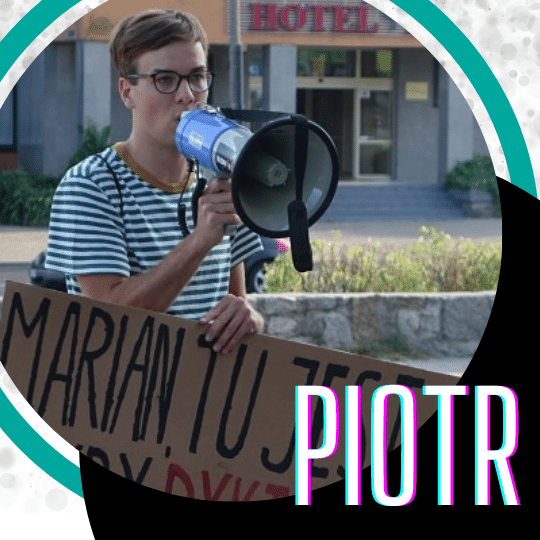
You will have new roads, but nobody to drive on them | Piotr Czerniejewski
Meet Piotr Czerniejewski, a Polish Youth and Climate Activist who is actively involved in the Just Transition process of his local area and has been promoting the inclusion of young people.

We need to make climate education a reality | Emilia Rygielska
Emilia is a 17 years-old activist and climate educator from Poland. In the following article, she talks about her experience with teaching kids about the climate crisis and why she thinks that politicians stand in the way of change.

Make at least one small eco change in your life | Ola Czajkowska
Social media on environmental issues can sometimes be the only source of knowledge for young Poles. Ola Czajkowska, a 26-year-old resident of Warsaw, has taken matters into her own hands.

It’s our time now! – Andjela Radun | Interview | Showcasing the Unheard
Introducing Andjela Radun – a 19-year-old environmental activist from Novi Sad, Serbia. She is part of Extinction Rebellion and Fridays for Future and other environmental movements where she campaigns against water pollution, air pollution, and deforestation that impact her home.

You will have new roads, but nobody to drive on them | Piotr Czerniejewski
Meet Piotr Czerniejewski, a Polish Youth and Climate Activist who is actively involved in the Just Transition process of his local area and has been promoting the inclusion of young people.

We need to make climate education a reality | Emilia Rygielska
Emilia is a 17 years-old activist and climate educator from Poland. In the following article, she talks about her experience with teaching kids about the climate crisis and why she thinks that politicians stand in the way of change.
Introducing Ia | Showcasing the Unheard
https://yeenet.eu/wp-content/uploads/2023/10/ia3.png 675 675 YEE https://yeenet.eu/wp-content/uploads/2018/11/logo-yee-728x1030.png YEE2023-06-02 16:09:072023-10-02 16:11:10Introducing Ia | Showcasing the UnheardOur mission
 YEE aims to unite environmental youth non-profit organisations in Europe in order to enhance international cooperation, increase knowledge about the climate crisis, raise awareness of environmental problems and to strengthen participation of youth in environmental decision-making.
YEE aims to unite environmental youth non-profit organisations in Europe in order to enhance international cooperation, increase knowledge about the climate crisis, raise awareness of environmental problems and to strengthen participation of youth in environmental decision-making.
Get in touch
Vinohradská 2165/48
120 00 Praha 2 – Vinohrady
Czech Republic
E-mail: yee@yeenet.eu


Financially supported by the European Youth Foundation of the Council of Europe. The views expressed do not necessarily reflect the official position of the Council of Europe







